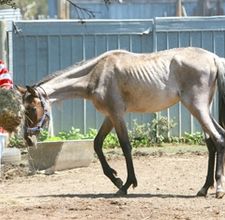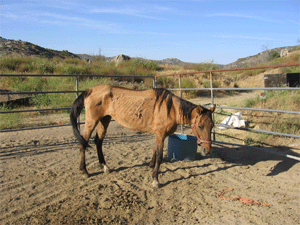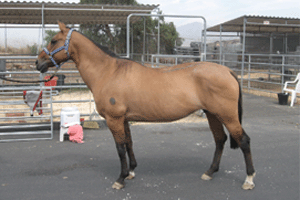How to Feed a Starving Horse
 We have recently taken an older horse into our care who was retired from work due to his declining health. He was unable to live in a herd enviroment and fend for himself anymore and so he has come to us so that he can recieve personalized care and feeding.
We have recently taken an older horse into our care who was retired from work due to his declining health. He was unable to live in a herd enviroment and fend for himself anymore and so he has come to us so that he can recieve personalized care and feeding.
Although this horse came from a good home and was by no means a ‘rescue’ it did make me think about all the rescue horses that we have nursed back to health and what a difficult and long journey it can be.
Taking in and bringing a starving horse back to health should always be approached with adequate information and preperation for the task ahead and this article helps you to understand a little of what this involves…
—————————————————
If a malnourished horse has come under your care, it is important you know that feeding him is delicate. The horse’s stomach is a fragile organ, prone to distension and colic and other problems, so you have to carefully monitor the feed a malnourished horse receives, and make adjustments accordingly.
Instructions
ONE—-It is a sight that is far too common these days–horses starved to the point of death or near death. If you are kind enough to try and help, remember that no good deed is easy, and often you will find yourself wondering why on earth you got yourself into this mess.
But you can save an animal’s life and they will be forever grateful for it. Rescued horses, for the most part, are very like rescued dogs. They know you have saved them from a horrible fate.
TWO—-The first and most important thing you need to do is have the horse you are going to rehabilitate examined by a veterinarian. The vet will give the horse a body condition score. This ranges from 0 (death by starvation) to 10 (about to die from obesity).
A healthy horse ranges right in the middle. A starved horse will typically run from 1-3. If your horse scores a 1, be prepared that it may not live, no matter how carefully you try to manage it.
Have the vet determine the extent of the damage of the starvation, and be sure to have the vet look at the horse’s teeth and also determine what kind of worm infestation it may have. This will give you somewhere to begin.
THREE—-Once you have an idea of the overall condition of the animal, you can begin an aggressive rehabilitation program. Do not feed the horse grain
immediately; if you do you may kill it. Just like you don’t feed a starving person a steak, you don’t feed a starved horse a rich diet.
Start with a low protein grass hay, as much as he can eat. If you can put a round bale in front of the horse, that would be excellent. Chances are the horse will eat very slowly. In fact, in some cases, they may not want to eat and you may have to tempt them with a sweet feed slurry (warm water, vegetable oil and sweet feed mixed together).
Horses, like humans, begin to digest themselves after a period of time, and their stomachs may be covered with ulcers and unaccustomed to food. You will have to reintroduce it gradually.
FOUR—-After a few days, the horse should be showing improved appetite. When this occurs, it is time to de-worm the animal for five days in a row with a
gentle de-wormer such as Safeguard or Panacur. Be prepared for a massive die-off of parasites.
If your horse is extremely weak, it might be best to worm it once every two weeks for a month, then do the five day treatment. When the horse is eating the hay well, it is time to introduce alfalfa.
FIVE—-Alfalfa is the best thing for a starved horse. No amount of grain, fats, or other supplements can achieve the same overall improvement as alfalfa for a malnourished horse. Begin with 1/2 flake twice a day in addition to all the grass hay he can eat. Gradually, over a period of at least two to three weeks, increase the amount of alfalfa until the horse is eating as much as he wants.
Be sure and include a mineral block for the horse to lick at all times, and make sure he has tons of clean fresh water, as the alfalfa will demand a lot more moisture intake for him. Depending on the condition your horse started in, you can expect recovery to happen in as little as two months, or as long as a year.




